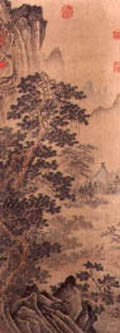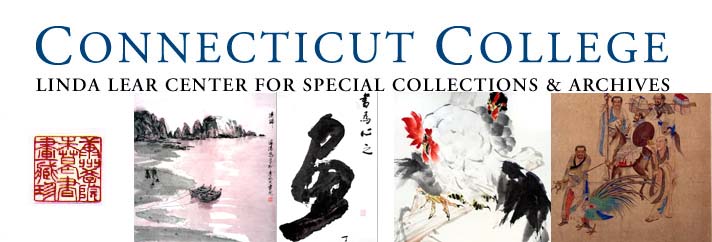Landscape Paintings
Ma Yuan (1190 - 1225)
Hanging Scroll, Ink and Color on Rice Paper, 24 x 13 in., (86 x 33 cm.)
 This is a print of a Ma Yuan landscape. I choose it with two purposes in mind. One is to explain the switch from monumental style such as "Visiting Tai on a Snowy Night" to a reduced format in the Southern Song era (1127 - 1279). The new trend in painting landscapes was to depict scenic nature in a gentler, simpler, more lyrical and intimate mood. Secondly, this was an era when Zen philosophy and Neo-Confucianism prevailed. The former emphasized a spontaneous splash-ink method of painting, and the latter stressed rationalism. Ma Yuan, being the Court Academy painter much influenced by a few masters before him, kept his acquired techniques and was bold enough to use ink wash liberally creating more empty space to make the painting open and airy. Landscape Painting became a means of personal expression. His small album and fan paintings express even more clearly what was on his mind. (His paintings can be viewed at the Metropolitan Boston Museum and Smithsonian.) When the next dynasty ruled China under the Mongols (1279 - 1368), the change in personal styles became even more literal and scholarly. Ma Yuan was an important link between realistic paintings of an earlier era and literati painting after him.
This is a print of a Ma Yuan landscape. I choose it with two purposes in mind. One is to explain the switch from monumental style such as "Visiting Tai on a Snowy Night" to a reduced format in the Southern Song era (1127 - 1279). The new trend in painting landscapes was to depict scenic nature in a gentler, simpler, more lyrical and intimate mood. Secondly, this was an era when Zen philosophy and Neo-Confucianism prevailed. The former emphasized a spontaneous splash-ink method of painting, and the latter stressed rationalism. Ma Yuan, being the Court Academy painter much influenced by a few masters before him, kept his acquired techniques and was bold enough to use ink wash liberally creating more empty space to make the painting open and airy. Landscape Painting became a means of personal expression. His small album and fan paintings express even more clearly what was on his mind. (His paintings can be viewed at the Metropolitan Boston Museum and Smithsonian.) When the next dynasty ruled China under the Mongols (1279 - 1368), the change in personal styles became even more literal and scholarly. Ma Yuan was an important link between realistic paintings of an earlier era and literati painting after him.
In short, I hope that by showing these few samples of Chinese landscape paintings we all see that painting styles do change with the times. Rules were emphasized in the T'ang time (618 - 907). Later in the Song period, rationalism revailed. In the Yuan dynasty, personal taste for poetry and lofty ideals claimed the day. Ma Yuan played his part in this procession.
This print is donated by Dr. Lily Shang, Switzerland. August, 1994.
